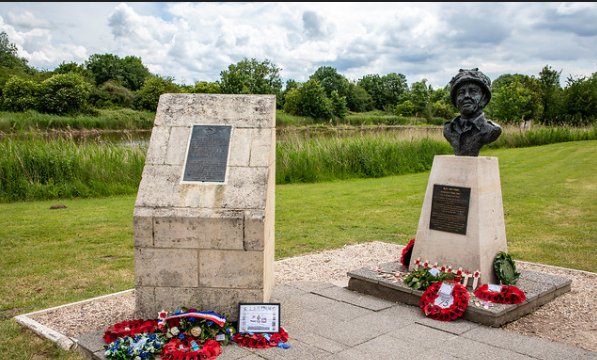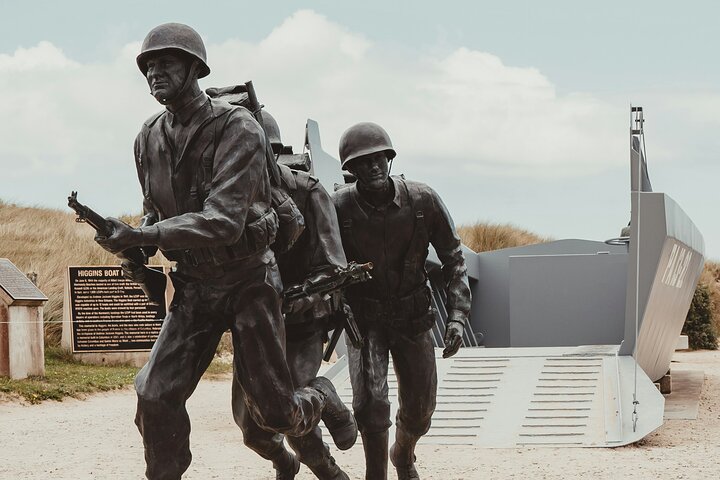On 6th June 2024, that’s a few days ago (exactly 80 years since 6th June 1944, D Day as it is well known), I watched the numerous telecasts, the video clips and read news items of the Anniversary of the D Day commemoration at Normandy in France. On this day eight decades ago Gen Dwight David Eisenhower, the Supreme Commander of the Allied Expeditionary Force had taken the toughest decision ever, by a human being when about 1, 65,000 troops were launched for the largest amphibious operation. The invasion force included 7,000 ships and landing craft manned by over 195,000 naval personnel from eight allied countries. The BBC reported on 6th June 1944 morning ‘Under the command of Gen Eisenhower, Allied Naval Forces supported by strong Allied Air forces began landing Allied Armies on the northern coast of France”. Thus began Operation Overlord with Operation Neptune being the landing of the invasion forces on the five beaches of Normandy (Omaha and Utah for the USA, Gold and Sword for the British and Juno for the Canadians) with D-Day signifying the start of Allied operations which would ultimately liberate Western Europe, defeat Nazi Germany and end the Second World War.
Just after midnight on 6th June, over 18,000 paratroopers of the US 101st and 82nd Airborne Divisions and the British 6th Airborne Division were dropped into Normandy to destroy vital installations and prevent a German counter strike to defeat the invasion at the five beaches at Normandy that June 6th morning.
On 5th June night, 180 troops of 2nd Battalion Oxford and Bucks Light Infantry led by Maj John Howard, in Horsa gliders made a precision landing to capture Pegasus Bridge, and also “Horsa Bridge”, a few hundred yards/metres to the east, over the Orne River. The object of this action was to prevent German armour from crossing the bridges and attacking the eastern flank of the landings at Sword Beach, and to prevent the British 6th Airborne Division from being cut off. The Ox and Bucks were reinforced at 0300h on D Day by forces of the 7 Parachute Battalion with Lt Richard Todd (a Hollywood actor, subsequently who played the role of Maj John Howard in the movie, ‘The Longest Day’) in the lead for the link up with the glider borne forces. They were linked up by Brig Lord Lovat’s commandos of the 4th Special Service Brigade. Lovat led the men off the landing craft; Lord Lovat’s brigade went ashore under fire near Coleville. His Commandos had discarded helmets at the last moment and donned their distinctive green berets, complete with their regimental cap badges. Lovat led the men off the landing craft, and Piper Millin floundered toward the beach, Lovat shouted, “Give us ‘Highland Laddie,’ man!” Shivering and waist deep in the water now, Millin put the mouthpiece to his lips and started playing as he struggled through the surf.
They achieved their task well by 0015h on D Day. The bridge which they had captured is now called the ‘Maj John Howard Bridge’.
I had the great opportunity of visiting the SHAEF (Supreme Headquarters Allied Expeditionary Force) in Southwick House, Portsmouth in England and have seen the original D Day map with the Tactical settings for that day. It was a great experience being shown around the place and seeing the operations room for Operation Overlord as it is referred to. Subsequently I had lunch in the Golden Lion Pub, which during the Second World War had been the Officer’s Mess for Generals Eisenhower, Montgomery, Bradley and the senior commanders who would be the leaders for ‘Operation Overlord’. I had enjoyed my Fish n Chips lunch and a salmon salad (with beer and white wine) while I listened intently to the owner of the Pub and his stories of the Officer’s Mess of World War 2. He said that his father had been the owner of this place when the architects of Operation Overlord used it as their Officer’s Mess. There was a nice corner in the lounge there with a scarlet-coloured leather sofa set where apparently important discussions about the forthcoming invasion would take place between the senior commanders in May 1944.
There was a thick forested area behind the pub which in April 1944 had lodged some of the Invasion forces in sausage shaped structures. This is there in the movie, ‘The Longest Day’. After lunch I went to the 5th June 1944, embarkation points, the jetty from where the convoy of ships had sailed for the invasion. The place is well maintained and the benches there speak of their tribute to the gallant soldiers who had participated in the sea borne assault.

Caption : Benouville; France – Major Howard statue near the Pegasus bridge
I subsequently visited Omaha, Utah, Sword and Gold Beaches. I had also visited St Mere Eglise, and Bayeux, the Benouville Bridge near the Gondree Cafe. I had met Mme Arlette who runs the cafe now. She was about 4 years old when the Invasion began with Maj Howard’s company of the Ox and Bucks capturing the twin bridges intact by 0015h on D Day with their precision glider assault near the bridge.
Mme Arlette was very kind to brief me on what actually had happened on D Day (as gathered from her parents, the owners of Gondree Cafe) there, then in June 1944. I enjoyed my lunch and wine as I heard her narration with rapt attention. She drew excellent sketches (of the Glider assault) on the paper napkins. It was superbly accurate. There was a group of European and American tourists with a French guide at the adjacent table. They gave me respect and honour when they realised that I was an Indian Army war veteran visiting there.
The War Memorial at Omaha evokes sentiments for the approximate 4000 troops who made the supreme sacrifice for humanity that day, the Longest Day, as very correctly coined by Field Marshal Erwin Rommel on the Atlantic Wall.
The Allied Invasion succeeded after a bitter close quarter battle on the beaches, but at a very heavy cost in young human lives.
My visit to nearly all the areas of the Invasion sites exactly 20 years ago, in 2004, had coincided with the Diamond Jubilee of D Day. The museum at Omaha and Utah beaches has recorded commentaries of D DAY as it unfolded then. I stood in mute silence as I saw the waves gently kissing the sands on the shores of the beaches three score years after 6th June 1944. It was calm and serene now but during the war it had been a bloody battle zone with heavy bombardment, full of misery for those who had fought.

Normandy, France; Memorial to the Andrew Jackson Higgins and the Higgins landing
I saw the film clips in some displays in the museum, showing Bayeux being liberated first, then Paris and the tumultuous welcome to the Allied forces by the locals as they had entered these towns and cities. I had stayed a night in Bayeux in a hotel and had dinner in a restaurant, whose owner was the daughter of a French couple that had witnessed the invasion on D Day.
My mind had raced back to December 1971 in East Pakistan then, when we made Bangladesh or rather had liberated it from similar tyranny as was done in Europe in World War 2.
Our forces in Jessore and Khulna were welcomed in the same manner and I had experienced that in the 1971 War in that sector and also had witnessed the surrender.
D Day and the allied invasion at Normandy during the Second World War, stands out as the finest amphibious invasion to defeat Nazi Germany, rid Europe from tyranny, end the Second World War and restore human values.
Having studied this campaign in the National Defence Academy and subsequently in the Army for various promotion and competitive examinations, and having seen the movie, The Longest Day, it was my desire fulfilled to visit these places and also meet some veterans of D Day.
We remember with great honour and respect those who had made the supreme sacrifice for humanity, in the line of Duty to become
*Liveth for Evermore*
They were the actual heroes and this 80th Anniversary of D Day, some Veterans in their Nineties and three of them Centurions, (the oldest being 107) were attired very appropriately with their medals and caps, being pushed in their wheelchairs with teary eyes as they remembered their fallen colleagues in battle on D Day.
This demonstrated the true value of camaraderie and regimental spirit for the Armed Forces as one large family of ‘Comrades in Arms’ this would be a classic example for generations to come in maintaining the ethos and values of the Armed Forces.








